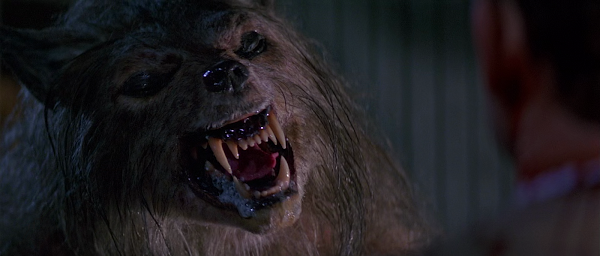'This creature's not shy. In most monster movies the beast isn't shown with absolute clarity, but in this one you see him in tight close-ups when he attacks the house at the end. He's surrounded by the home's interior lighting.'
This made the film daunting from an effects point of view, as one reason most werewolf movies favored quick cuts and shadowy lighting was to hide any potential defects in suits and prosthetics. Most effects houses balked at the challenge, with Red settling on Steve Johnson; 'I hired (...) Johnson's XFX after a long search because I found them to be the most realistic in terms of (current makeup effects technology).'
XFX supplied the prosthetic makeups, such as slashing wound appliances and a series of transformation makeups applied on Michael Pare as his character transforms into a werewolf. The second stage makeup was a 'demonic' look with shaggy hair punched on the appliances. Much more ambitious was the final stage transformation appliance that Johnson had sculpted for Pare to wear, as Uncle Ted's transformation intensifies. The lopsided, malformed makeup, an advanced remake of Johnson's makeup for Stephen Geoffries in Fright Night, was another attempt by Johnson to realize his vision of how a werewolf should transform;
'Ever since The Howling and American Werewolf in London I'd felt that, if a person was changing into a wolf, why would it happen evenly and symmetrically? Why wouldn't one side of the body boil up suddenly, followed by the other side?'
The transformation makeups were then enhanced (or, looking back, ruined) by digital technology - 'morph' effects had already been used for monster transformations in Sleepwalkers and Full Eclipse, but Johnson was still hopeful in it.
'This is the first werewolf movie made since digital technology has become so accessible so we have a really nicer marriage of animatronics, prosthetics and digital technology. We linger on the transformation in this film, and I think that for the first time we're going to have a genuinely gradual and asymmetrical transformation that pays off.'
'We fucked up!' was how Eric Red described the choice years later, as Bad Moon's digital transformation went down as one of the worst in horror film history. The reputation was so bad that the director's cut removed it entirely. When Neil Marshall directed Dog Soldiers, he made sure to avoid using 'cheesy morph effects', clearly a reference to Bad Moon.
The effects highlight of Bad Moon was its werewolf, which was required not just to walk around on-camera without cuts, but also grapple with attack dogs for fight scenes! Johnson found a way to get around the usual problem of werewolf suits, by doing away with wolf-like legs.
'We wanted to fashion a creature that was very wolflike in the upper body and head, but more or less human from the chest on down'. Johnson also said the design inspiration came from 'a Warren Publishing magazine cover'; perhaps Frank Frazetta's werewolf painting for Creepy #4.
Johnson, along with sculptor Bill Corso who fashioned the head, wished to emphasize the wolfish elements more than previous werewolf suits. Johnson made sure to give the Uncle Ted wolf a sloping neck like those of real wolves and coyotes; this would also have the benefit of having the animatronic head in front of the performer's head rather than directly on top.
Johnson elaborated on the other wolfish aspects of the suit; 'I also wanted genuine wolf colouration, which was rarely been done, so we had the fur tipped and multicoloured like it is on real wolves and coyotes. And this time, we decided against a bald muzzle. In my opinion, this one's an improvement on the designs for Howling and American Werewolf'.
The puppet heads in gruesome action.
Several heads were made, including an animatronic 'hero' head, and a puppet head that would be used for closeup shots of the werewolf devouring its victims. An exploding dummy head was also made for the opening sequence. The head was so wolf-like that it intimidated most of the attack dogs used in filming, making them unwilling to attack the performer in the suit!
Inside the rubber suit was Ken Kurtzinger, who was made to endure the usual trials and tribulations of a creature suit performer, as Eric Red humorously recalled;'There are some scenes with Ken wearing a full-body werewolf suit, and there wasn't much room in the thing for air. It was made with six layers of latex to prevent the German shepherd from biting through, and Ken was also wearing this animatronic werewolf head as the costume's crowning touch.
After a while, he began to complain about the heat in this getup, but it was tough to look serious, supportive and sympathetic with these gripes popping out of a werewolf's mouth. Here was this huge, formidable beast moaning and groaning about itchiness and sweat. I couldn't help but tease him about it.' A 'weredog' puppet was also designed and constructed by XFX for the jumpscare dream sequence of lovable dog Thor having been contaminated by lycanthropy - sadly haven't been able to find any usable behind the scenes photos of the weredog puppet yet, but Eric Red did post some tiny resoluation images on his twitter account.
(I really, really wish these photographs were scanned in better quality, because it's such a tease! These sculpting and animatronic test images!) Johnson was proud of his work on Bad Moon, to the point that he had a posable dummy made of Uncle Ted for display at XFX's shop. The dummy was made from a new casting of the original Uncle Ted sculpt, and was fabricated by the same people, but was otherwise a copy made for display and promotional photos. The fur is the biggest difference between the dummy Uncle Ted and the original Uncle Ted suit, as the dummy has a less grey-ish colouration.
Sources:
- Fangoria #158 and #159
- Assorted bluray featurettes







































No comments:
Post a Comment